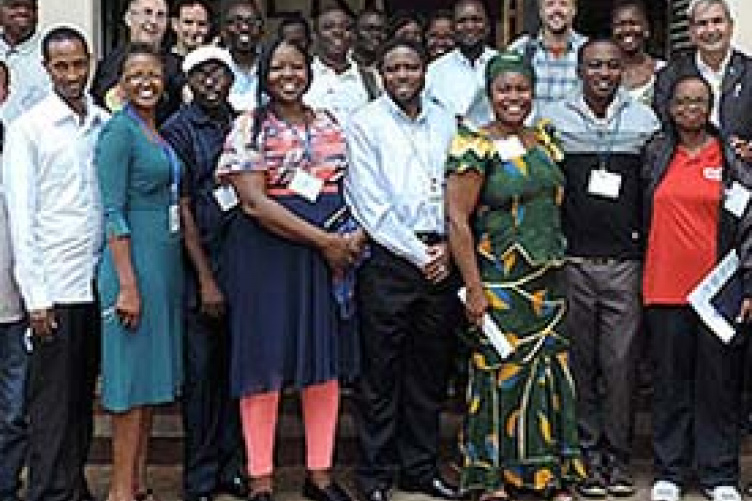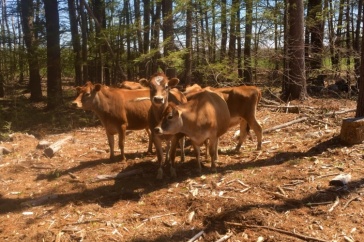
Instructors and students of the African Plant Breeding Academy in Nairobi, Kenya.
In the backyard gardens of sub-Saharan Africa, many people plant traditional strains of millet, teff, pigeon pea, cassava, vegetable amaranth, and groundnut to provide for their daily nutrition. Meanwhile, large swaths of agricultural land are devoted to intensively researched and improved varieties of cacao, cotton, and maize.
“Farmers have been pushed to grow cash crops for exports — or global commodity crops relatively ill-suited to the growing conditions — while the ‘orphan crops' of the continent have largely been ignored by researchers, breeders, and agribusiness,” says Iago Hale, assistant professor of specialty crop improvement in the College of Life Sciences and Agriculture. One example of an “orphan crop” is the baobab tree, which lacks broad economic appeal in the global market even though its fruits contain high levels of potassium and antioxidants and serve as an important source of nutrition in some communities.
|
Iago Hale, assistant professor of specialty crop improvement in the College of Life Sciences and Agriculture |
The disparity of this focus on cash crops has contributed to a larger problem of malnutrition that includes the physical stunting and lack of proper neurological development in an estimated 47 percent of children throughout rural Africa. According to Save the Children’s A Life Free from Hunger: Tackling Childhood Malnutrition, 300 children die from malnutrition every hour of every day. Even when children survive malnutrition, they are unlikely to reach their physical and mental potential after suffering such severe nutritional deficits during key developmental stages in early life.
In 2011, the Clinton Global Initiative spawned the African Orphan Crops Consortium (AOCC) in an effort to improve the nutritional profile, productivity, and climatic adaptability of traditional African food crops. At the core of the AOCC vision is the objective to sequence, assemble, and make publically available 10,000 orphan crop plant genomes, or 100 genotypes each of 100 traditional crops. This would lay a technological foundation to help combat malnutrition.
A collaboration of researchers, corporations, and policy makers from the University of California, Davis; Mars Incorporated; the African Union; the World Agroforestry Centre; BGI; Life Technologies Corporation; the World Wildlife Fund; iPlant Collaborative; and BECA-ILRI, the consortium has raised approximately $40 million to carry out this work, as well as to support the development of the African Plant Breeding Academy (AfPBA).
Opened in December 2013, the AfPBA’s primary goal is to bring plant breeders together from around the continent and expand their understanding of molecular markers and genomic tools in order to improve those orphan crops routinely grown by 600 million smallholder African farmers and their families. Over the next five years, instructors at the AfPBA expect to train 250 African plant breeders in the use of genomic data and marker-assisted selection to develop more nutritious and resilient food crops for African farmers. In this way, the AfPBA serves as a necessary capacity building component of the AOCC, ensuring that the continent's breeders will be able to make full use of the unprecedented quantity of plant genomic data.
A core AfPBA's instructor, Hale feels “honored to be part of this historic initiative.” With his background in developing genetic and genomic resources for plant breeding and a special interest in improving food plants for developing nations, Hale is an integral part of a team that is teaching the first cohort of 27 plant breeders from 11 African countries who recently came together at the World Agroforestry Center (ICRAF) in Nairobi, Kenya.
While there, he taught the experimental design and statistical analysis component of an accelerated graduate-level plant-breeding program. “In Africa, many important food plants are still wild harvested and, while they may have promising nutritional profiles, their yields are down. Perhaps their post-harvest characteristics are poor, and they are overlooked as potentially marketable products,” says Hale. “We can support and revitalize the inherently diverse traditional diets of sub-Saharan Africa by investing in and improving the varieties of these orphan crops. African plant breeders need to know that it makes sense to be working on groundnut and minor legumes, and they need to be supported in that work.”
-
Written By:
Staff writer | Communications and Public Affairs


















































